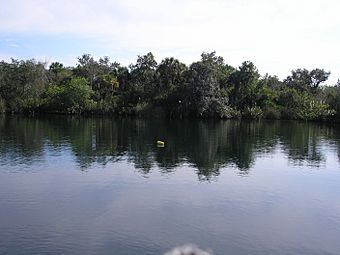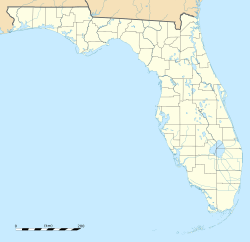Little Salt Spring facts for kids
Quick facts for kids |
|
|
Little Salt Spring
|
|

Little Salt Spring
|
|
| Location | North Port, Florida |
|---|---|
| NRHP reference No. | 79000692 |
| Added to NRHP | July 10, 1979 |
Little Salt Spring is a very special place in North Port, Florida. It's important for learning about ancient history and old animals. This amazing site is located right off Price Boulevard, near Heron Creek Middle School. On July 10, 1979, it was officially recognized and added to the National Register of Historic Places.
Since 1980, the University of Miami has owned Little Salt Spring. Scientists from their Rosenstiel School of Marine and Atmospheric Science study the site.
Contents
Exploring Little Salt Spring
Little Salt Spring is a type of natural hole in the ground called a sinkhole. It formed in Florida's karst topography, which is land made of soft rocks like limestone. Water slowly dissolves these rocks, creating caves and sinkholes.
What Makes the Spring Special?
Deep holes at the bottom of the sinkhole bring in water that has very little oxygen. This creates a special environment below about 5 meters (16 feet) deep. Because there's almost no oxygen, things like old tools, plant remains, and even bones of giant, extinct animals are kept safe. It's like a natural refrigerator that preserves history!
Scientists first thought Little Salt Spring was a shallow pond. But in the 1950s, SCUBA divers explored it. They found it was a deep sinkhole, going down over 60 meters (200 feet)! It's similar to the cenotes you might find in Mexico's Yucatán Peninsula.
How Deep is the Spring?
The top part of the spring is about 12 meters (40 feet) deep. From there, a narrow shaft drops down. This shaft opens into a wider, upside-down cone shape. The deepest part found so far is about 75 meters (245 feet) down! There are also ledges around the sinkhole walls. These ledges are about 16 and 27 meters (52 and 89 feet) below the water's surface.
Ancient Life at Little Salt Spring
The water level in Little Salt Spring has changed a lot over thousands of years. About 12,000 to 13,000 years ago, the ocean was much lower. This made the water level in the spring about 27 meters (89 feet) lower than it is today.
Discoveries in the Peat
The area around the spring and a nearby slough (a swampy channel) are filled with soft, wet soil called peat. Many ancient burials have been found in this peat. These burials date back between 5,200 and 6,800 years ago. In some cases, even brain matter survived inside the skulls, which is very rare! This has also happened at other Florida sites like the Windover Archaeological Site.
The Giant Tortoise Mystery
In the 1970s, something incredible was found on the 27-meter (89-foot) ledge. It was the overturned shell of a giant land tortoise that is now extinct. A wooden stake had been pushed between its top and bottom shells. There was also evidence of a fire underneath the tortoise. It seems like someone cooked this huge tortoise right in its shell!
Scientists used a method called radiocarbon dating to find out how old these things were. The wooden stake was about 12,030 years old. A bone from the tortoise itself was even older, about 13,450 years old. Many human bones have also been found in the spring.



